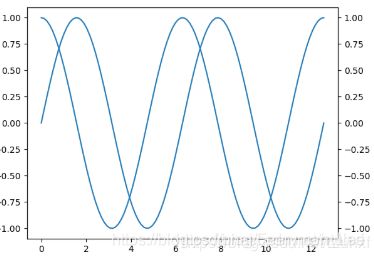python 可视化:fig, ax = plt.subplots()画多表图的3中常见样例 & 自定义图表格式
python 可视化:fig, ax = plt.subplots()画多表图的3中常见样例 & 自定义图表格式
一、fig, ax = plt.subplots()的作用?
它是用来创建 总画布/figure“窗口”的,有figure就可以在上边(或其中一个子网格/subplot上)作图了,(fig:是figure的缩写)。
plt.subplot(111)是plt.subplot(1, 1, 1)另一个写法而已[引用链接],更完整的写法是plt.subplot(nrows=1, ncols=1, index=1)
fig, ax = plt.subplots()等价于fig, ax = plt.subplots(11)
fig, axes = plt.subplots(23):即表示一次性在figure上创建成2*3的网格,使用plt.subplot()只能一个一个的添加
fig = plt.figure()
ax = plt.subplot(231)
ax = plt.subplot(232)
ax = plt.subplot(233)
ax = plt.subplot(234)
ax = plt.subplot(235)
ax = plt.subplot(236)
二、参数的含义?
首先看 fig = plt.figure()
matpltlib.pyplot.figure(
num = None, # 设定figure名称。系统默认按数字升序命名的figure_num(透视表输出窗口)e.g. “figure1”。可自行设定figure名称,名称或是INT,或是str类型;
figsize=None, # 设定figure尺寸。系统默认命令是rcParams["figure.fig.size"] = [6.4, 4.8],即figure长宽为6.4 * 4.8;
dpi=None, # 设定figure像素密度。系统默命令是rcParams["sigure.dpi"] = 100;
facecolor=None, # 设定figure背景色。系统默认命令是rcParams["figure.facecolor"] = 'w',即白色white;
edgecolor=None, frameon=True, # 设定要不要绘制轮廓&轮廓颜色。系统默认绘制轮廓,轮廓染色rcParams["figure.edgecolor"]='w',即白色white;
FigureClass=<class 'matplotlib.figure.Figure'>, # 设定使不使用一个figure模板。系统默认不使用;
clear=False, # 设定当同名figure存在时,是否替换它。系统默认False,即不替换。
**kwargs)
然后看ax = plt.subplot()
三、怎么在一个图上排列多个子图?
比如说我们想画个2*2的子图,每个子图对应一个表。
先重点考虑2个步骤。
第1个步骤:创建多维窗口:
fig, axes = plt.subplots(2, 2) # 此处是一个2*2的图
第2个步骤:设定各个透视子图在窗口的位置:
data.plot.bar(ax=axes[1,1], color='b', alpha=0.5) # ax=[1,1] 即位置是第2行、第二列。(python从0开始计数,所以“1”代表第2的)
data.plot.barh(ax=axes[0,1], color='k', alpha=0.5) # alpha:设定图表的透明度;
再添加子透视图代码。
第3个步骤:得到完整的代码:
import pandas as pd
import numpy as np
import matplotlib.pyplot as plt
fig, axes = plt.subplots(2, 2)
data = pd.Series(np.random.rand(16), index=list('abcdefghijklmnop'))
data.plot.bar(ax=axes[1,1], color='b', alpha = 0.5)
data.plot.barh(ax=axes[0,1], color='k', alpha=0.5)
plt.show()
四、怎么把多个子图一起合并到一个图上?
最主要的一点是让多个图线共用一个x坐标轴。
语句规定N个折线图共用一个x坐标(注意:y轴分主副轴)
import numpy as np
import matplotlib.pyplot as plt
fig, ax1 = plt.subplots(1, 1) # 做1*1个子图,等价于 " fig, ax1 = plt.subplot() ",等价于 " fig, ax1 = plt.subplots() "
ax2 = ax1.twinx() # 让2个子图的x轴一样,同时创建副坐标轴。
# 作y=sin(x)函数
x1 = np.linspace(0, 4 * np.pi, 100)
y1 = np.sin(x1)
ax1.plot(x1, y1)
# 作y = cos(x)函数
x2 = np.linspace(0, 4 * np.pi, 100) # 表示在区间[0, 4π]之间取100个点(作为横坐标,“线段是有无数多个点组成的”)。
y2 = np.cos(x2)
ax2.plot(x2, y2)
plt.savefig('sin_cos_2.png') # 将窗口另存为png格式图片
 如果需要x轴y轴都一样:就把ax1和ax2它俩用ax一个取代了。
如果需要x轴y轴都一样:就把ax1和ax2它俩用ax一个取代了。
自定义图表样式:比如旋转x轴标签、上边和右边的坐标轴不显示、曲线和y轴对齐等
import matplotlib.pyplot as plt
plt.rcParams['font.family'] = ['SimHei'] # 解决不能输出中文的问题。不区分大小写,即SimHei’效果等价于‘simhei’,中括号可以不要
plt.rcParams['figure.autolayout'] = True # 解决不能完整显示的问题(比如因为饼图太大,显示窗口太小)
fig, ax = plt.subplots(1, 1, figsize=(12, 9)) # 进一步设定fig的size为12*9
ax.spines['top'].set_visible(False) # 不显示图表框的上边框
ax.spines['right'].set_visible(False) # 不显示图表框的右边框
ax.set_xlim(0, 10) # 有时候x轴不会从0显示,使得折线图和y轴有间隙
ax.set_ylim(0, 1.3e8) # 和x轴同理
plt.xticks(range(0, 10), fontsize=12, rotation=80) # 针对x轴的标签,指定我们想要设定的范围是(0, 10), 字体大小是12, 逆时针旋转80°
plt.tick_params(bottom='off', left='off', labelbottom='on', lableleft='on') # 使x轴和y轴不带比例标识点, labelbottom设定下边、即x轴的标签是否显示。
< blabla... >
plt.suptitle('自定义图表', fontsize=400, ha='center') # 即标题在x轴和y轴形成的方框内部,如下图(详细用法见下注释)。如果需要标题在这上方,使用 plt.title(blabla)
plt.show()
"""
对于multiple subplots一般情况下,
1)设置 plt.xticks(range(0, 10))只会对最后一个ax起作用。要想作用于所有subplots,要这样:
for ax in axes:
ax.set_xticks(range(0, 10))
2)标题:显示中文方面-在各个子图上要这样:
plt.title('某个子图的中文title', fontproperties='simhei'),
因为plt.rcParams['font.family'] = 'simhei' 只对整体的标题是有效的。
整体的标题要这样设置:
plt.suptitle(‘全体子图的中文title’)
3)xticks的旋转方面。例如上面的主副坐标轴的共x轴,要这样:
ax1.set_xticklabels(['str format labels'], rotation=80)
而这样的设置无效:plt.xticks(x, rotation=80)。
"""
matplotlib.pyplot.suptitle(
t, # text缩写。即标题文字。
fontsize | size, # 设定字体大小。
x, # 设定标题相对于x轴的位置,默认是'0.5'。
y, # 设定标题相对于y轴的位置,默认是'0.98'。
ha | horizontalalignment, # 和参数x一起使用,设定标题水平方位,默认是‘center’。共3个可选值{'center', 'left', right'}。
va | verticalalignment, # 和参数y一起使用,设定标题垂直方位, 默认是'top'。共4个可选值{'top', 'center', 'bottom', 'baseline'}。
fontweight | weight # 设定字体权重。
)

